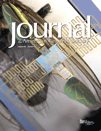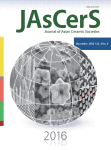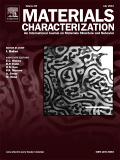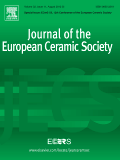
JOURNAL OF THE AMERICAN CERAMIC SOCIETY
Scope & Guideline
Exploring the Depths of Ceramic Materials Knowledge
Introduction
Aims and Scopes
- Material Synthesis and Processing:
Research on the development and optimization of synthesis routes for various ceramic materials, including advanced techniques like spark plasma sintering and flash sintering. - Structure-Property Relationships:
Exploration of the link between the microstructural characteristics of ceramics and their macroscopic properties, such as mechanical, thermal, and electrical behavior. - Innovative Applications:
Investigation into novel applications of ceramic materials across diverse fields including electronics, energy storage, environmental remediation, and biomedical devices. - Computational Modeling:
Use of computational methods, including first-principles calculations and machine learning, to predict material behavior and guide experimental design. - Environmental and Sustainability Studies:
Research aimed at understanding the environmental impact of ceramics and the development of eco-friendly materials and processes. - Advanced Characterization Techniques:
Application of advanced analytical techniques, such as electron microscopy and spectroscopy, to study the structural and functional properties of ceramics.
Trending and Emerging
- High-Entropy Ceramics:
Research on high-entropy ceramics is on the rise, focusing on materials with complex compositions that improve thermal stability and mechanical properties. - Nano-Structured Ceramics:
Emerging studies emphasize the synthesis and applications of nano-structured ceramics, which promise enhanced performance in various applications due to their unique properties at the nanoscale. - Environmental Barrier Coatings:
There is a growing interest in developing environmental barrier coatings for high-temperature applications, particularly in aerospace and energy sectors, to improve material durability and performance. - Machine Learning and AI in Ceramics:
The integration of machine learning and artificial intelligence in ceramics research is becoming more prevalent, enabling predictive modeling and accelerated materials discovery. - Bioceramics and Biomedical Applications:
Research on bioceramics for medical applications, including bone regeneration and drug delivery systems, is rapidly expanding, reflecting the increasing intersection of materials science and healthcare. - Smart and Multifunctional Ceramics:
Emerging interest in the development of ceramics that can perform multiple functions, such as sensing, energy harvesting, and self-healing, is gaining momentum in the field.
Declining or Waning
- Traditional Ceramic Materials:
Research on conventional ceramics, such as standard porcelain and earthenware, has decreased as the field moves towards advanced materials with enhanced functionalities. - Basic Sintering Techniques:
Studies focusing solely on traditional sintering methods without innovative enhancements or modifications have become less frequent as researchers seek more efficient processing techniques. - Historical Ceramic Analysis:
Papers dedicated to the historical and archaeological analysis of ceramics have declined, likely due to a growing emphasis on contemporary applications and advanced materials. - Single-Function Ceramics:
Research on ceramics designed for single functionalities, such as basic thermal insulation without multifunctional advantages, is being overshadowed by the development of multifunctional ceramic systems.
Similar Journals

Crystals
Illuminating the World of Crystals Through ResearchCrystals is a premier open-access journal, published by MDPI since 2011, that focuses on the multidisciplinary fields of chemical engineering, condensed matter physics, inorganic chemistry, and materials science. With its E-ISSN 2073-4352, the journal is headquartered in Switzerland, and actively contributes to the global scientific community by facilitating the dissemination of high-quality research. Ranking in the Q2 quartile across multiple categories, including Chemical Engineering (miscellaneous) and Materials Science (miscellaneous) for 2023, Crystals provides a platform for innovative studies that span from fundamental research to practical applications. The journal's commitment to open access ensures that groundbreaking findings are readily available to researchers, professionals, and students alike, fostering an environment of collaboration and knowledge sharing that is essential in advancing the scientific understanding of crystalline materials.

Journal of Asian Ceramic Societies
Advancing ceramic innovation across Asia.The Journal of Asian Ceramic Societies, published by Taylor & Francis Ltd, is a peer-reviewed open-access journal that has been at the forefront of ceramic research since its inception in 2013. With an ISSN of 2187-0764, this esteemed journal is dedicated to advancing the scientific understanding of ceramics and composites, bolstered by an impressive ranking of Q2 in the field of Materials Science. Covering a wide range of topics pertinent to ceramics, the journal aims to foster collaboration among researchers, professionals, and students across Asia and beyond. Its commitment to accessibility allows a global audience to engage with cutting-edge research, reflected in its Scopus ranking of #45 out of 127 in the Materials Science category. With a publication timeline extending to 2024, the Journal of Asian Ceramic Societies is an indispensable resource for anyone looking to stay informed on the latest developments and innovations in ceramic technology.

Journal of Superhard Materials
Fostering collaboration in the evolving world of superhard materials.The Journal of Superhard Materials, published by PLEIADES PUBLISHING INC, is a premier journal dedicated to advancing the field of superhard materials, including their synthesis, properties, and applications. With an ISSN of 1063-4576 and E-ISSN 1934-9408, this journal serves as an essential resource for researchers and professionals focused on material science and inorganic chemistry. As of 2023, it ranks in the Q3 category for both Inorganic Chemistry and Materials Science (miscellaneous), establishing its growing significance within the scientific community. The journal, located in the United States at PLEIADES HOUSE, New York, welcomes submissions that contribute innovative findings in the realm of superhard materials, fostering collaboration and knowledge exchange among scholars. Researchers interested in cutting-edge developments and applications in this niche area will find valuable insights and findings published in this journal, encouraging continued exploration and discovery in the materials sciences.

Composites Part C: Open Access
Disseminating Breakthroughs in Mechanics of MaterialsComposites Part C: Open Access, an esteemed journal published by Elsevier, is at the forefront of research in the fields of Ceramics and Composites, Mechanical Engineering, and Mechanics of Materials. Launched in 2020, this fully open-access journal facilitates unparalleled access to significant advancements in composite materials, ensuring that research findings are disseminated widely and freely throughout the global academic community. With an impressive Q1 ranking across multiple related categories and robust placements in Scopus rankings, specifically #78 in Mechanical Engineering and #24 in Materials Science, the journal serves as a vital platform for researchers, professionals, and students to publish their work and engage with cutting-edge studies. It aims to foster innovation and collaboration in the development and application of composite materials and their technologies, making it an indispensable resource for anyone invested in these dynamic fields.

Inorganic Materials-Applied Research
Exploring the Depths of Inorganic ApplicationsInorganic Materials-Applied Research is a pivotal journal dedicated to the dissemination of innovative research in the field of inorganic materials. Published by SpringerNature, this journal operates as a vital resource for researchers, professionals, and students alike, providing a platform for cutting-edge findings and methodologies related to the synthesis, characterization, and application of inorganic materials. With an ISSN of 2075-1133 and an E-ISSN of 2075-115X, the journal strives to bridge gaps in interdisciplinary studies, fostering collaboration across the engineering and materials science domains. Despite its current rankings placing it in the Q3 quartile for both Engineering and Materials Science categories, the journal aims for broader impact, seeking to enhance its visibility and contribution in publications through rigorous peer-review and open access options. Converged from 2010 to 2024, it remains committed to advancing knowledge and addressing contemporary challenges in materials science, thereby attracting contributions that are not only academically rigorous but also socially impactful.

MATERIALS CHARACTERIZATION
Transforming Knowledge into Practical ApplicationsMATERIALS CHARACTERIZATION is a leading international journal dedicated to the advancement of knowledge in the field of materials science and engineering. Published by Elsevier Science Inc, this esteemed journal has been disseminating vital research since 1970 and continues to be essential for scholars and industry professionals alike. With an impressive impact reflected in its Q1 quartile rankings across several categories—including Condensed Matter Physics, Materials Science, Mechanical Engineering, and Mechanics of Materials—MATERIALS CHARACTERIZATION stands out as a premier outlet for innovative studies and technical advancements. Researchers can access a wealth of peer-reviewed articles that explore properties, characterization techniques, and applications of materials, fostering interdisciplinary collaboration. With a commitment to high-quality research and comprehensive review processes, the journal plays a crucial role in shaping the future of materials science, making it an invaluable resource for anyone invested in this dynamic field.

Composites Theory and Practice
Innovating Through Materials Science and EngineeringComposites Theory and Practice is an esteemed academic journal published by the Polish Society of Composite Materials, dedicated to the exploration and advancement of research in the fields of ceramics, composites, materials chemistry, mechanical engineering, and mechanics of materials. Commencing its publication in 2019, the journal aims to disseminate high-quality research findings that contribute to the theoretical and practical understanding of composite materials, which are pivotal for technological innovation. With an ISSN of 2084-6096 and an E-ISSN of 2299-128X, it provides robust scholarship recognized within the academic community, albeit currently categorized in the Q4 quartile rankings across multiple relevant fields. Researchers and professionals seeking a platform to share transformative insights related to composite materials will find Composites Theory and Practice a valuable resource for advancing knowledge and application in this critical area of study.

Journal of the European Ceramic Society
Driving Progress in Ceramic ResearchThe Journal of the European Ceramic Society, published by Elsevier, is a premier academic periodical dedicated to the cutting-edge advancements in the fields of ceramics and composites, as well as materials chemistry. With an impressive impact factor that places it in the top quartile (Q1) of its category, it ranks #33 out of 317 in Materials Science and #16 out of 127 in Ceramics and Composites, showcasing its strong influence in the scientific community. Established in 1989 and set to converge until 2025, this journal serves as a critical platform for researchers and professionals to disseminate their findings, share ideas, and foster collaboration in the rapidly evolving area of ceramic materials. Although it does not offer Open Access options, the journal ensures rigorous peer review and maintains high standards for publication, making it an essential resource for students, academics, and industry experts who are pushing the boundaries of material science.

REFRACTORIES AND INDUSTRIAL CERAMICS
Exploring Innovations in Refractories and CeramicsREFRACTORIES AND INDUSTRIAL CERAMICS is a prestigious journal published by Springer, dedicated to the field of ceramics and composite materials. With an ISSN of 1083-4877 and an E-ISSN of 1573-9139, this journal plays a pivotal role in fostering advances in the development, formulation, and application of refractories and industrial ceramics. The journal has been actively publishing since 1996 and is recognized for its contribution to the academic discourse in the ceramics community. Although it currently holds a Q4 ranking in both Ceramics and Composites and Materials Chemistry categories, it serves as an important platform for emerging research trends and innovations, making it essential reading for researchers, professionals, and students engaged in material science. While access is not open, the journal ensures that high-quality research reaches its audience, reflects the evolving landscape of the ceramics industry, and encourages interdisciplinary collaboration.

Journal of Metals Materials and Minerals
Unveiling Breakthroughs in Materials and Mineral StudiesJournal of Metals Materials and Minerals (ISSN: 0857-6149) is a renowned academic publication dedicated to the interdisciplinary fields of metallurgical science, materials engineering, and mineralogy. Published by Chulalongkorn University, Metallurgy & Materials Science Research Institute in Thailand, this journal serves as a pivotal platform for researchers to disseminate their findings and explore innovative applications related to metals, ceramics, polymers, and biomaterials. Although the journal does not currently adopt an open-access model, it provides insightful content that facilitates knowledge sharing among professionals and academics alike. The journal has established its credibility with impressive Scopus ranking percentiles, particularly in categories such as Metals and Alloys and Ceramics and Composites. With an emphasis on advancing the understanding of materials science from 2017 to 2024, the Journal of Metals Materials and Minerals remains an essential resource for those striving to contribute to and stay informed about the latest trends and breakthroughs in these dynamic fields.